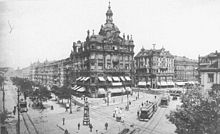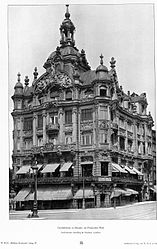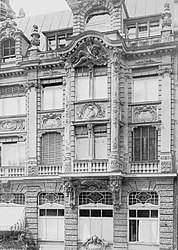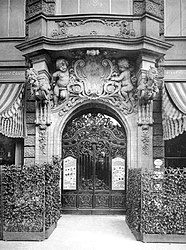Imperial Palace (Dresden)


The Kaiserpalast was a neo-baroque commercial building in Dresden that was destroyed in the air raids on Dresden in February 1945. It was built between 1895 and 1897 for the entrepreneur Hermann Ilgen and stood as a representative head building on the north side of Pirnaischer Platz between Moritzring and Amalienstraße. When the large area was cleared, the ruins were removed, and today there are green and traffic areas in their place.
History and description
The Kaiserpalast was supposed to replace the restaurant and café Pirnaischer Platz of the operator Otto Scharfe after the development of the surrounding area had made this establishment unattractive. The new building was financed by the pharmacist Hermann Ilgen. He bought the plot of land on which the future building was to stand and in 1894 put out an architectural competition for which he created clear usage specifications that adhered to the Dresden building regulations of the time, which required a representative design for the square, as well as a representative design, which had to be trained at least on the front sides of the Moritz and Amalienring.
Scharfe was to run a restaurant again in the four-story new building. The upper floors should either be used as a hotel or rented out as offices and studios. In the tender, Ilgen requested a two-story basement on the side facing Amalienstraße so that the drinks store of the future restaurant could be kept cool, and also a passage between Amalienstraße and Ringstraße on the ground floor, a third of which would be reserved for the restaurant and the rest of it to Pirnaischer Platz, should be occupied with shops. The total area of the first floor should be available for the restaurant and have a balcony, the second floor was intended for offices, the third should be suitable for a possible hotel or residential purposes and the top floor should be planned as a studio.
113 drafts had been submitted by the deadline of March 15, 1895. 103 were discarded, and Ilgen, one Mr. Rossbach and Professors Wallot and Gottschaldt dealt more intensively with ten drafts. They awarded the third prize of 500 marks to the architect Metzendorf from Elberfeld, and a second third prize to the Dresden architects Hermann Richter and Otto Förster. Two other designs that were not implemented were also shortlisted. One came from the Dresden architect Johannes Fischer, the other had the Saxon name "'s Bärnsche Dor". The first prize went to Th. Martin from Freiberg, who found a clever solution for the light shaft, but had equipped the planned office floors with bathtubs. It was finally decided to implement the design “Pomegranate in the Red Field” by the Dresden architectural duo Lossow & Viehweger, who had received the second prize, although the tender conditions meant that the office was not awarded the contract, but was settled with the prize money.
The architects Schilling and Graebner , who were based on the selected design by Lossow & Viehweger, received the order for the new building and had it built under their direction from 1895. The ground floor and the first floor were clad in sandstone . Unlike in the award-winning design, the balcony on the first floor was laid out all around. The upper floors were plastered and decorated with rich figurines, which were soon criticized as excessive. In an openwork gable in front of the dome of the building was an allegorical representation of the variety theater by Hans Hartmann-MacLean . Three wall paintings and one ceiling painting in the main hall of the Imperial Palace were by Otto Fischer .
The windows, especially a colossal window in the vestibule, were designed by Josef Goller .
Otto Scharfes Restaurant was opened in December 1897. It was located in this building until around 1920, after which its premises were used by Commerzbank . In 1940 the Frenzel, Schindler and Krumm shops were also rented in the building, as well as Deutsche Gasolin AG and the lawyers Barmann and Hennig, the Horst Meier photo studio and the singing teacher Doris Winkler. An apartment under the roof was used by the stoker of the imperial palace.
During the air raids on Dresden in February 1945, the Imperial Palace was badly hit and burned down. In the course of clearing large areas in 1951, the ruins were torn down. The space that was freed up was used for road traffic towards the main train station and for a green area. The cellars of the building are below these areas, although filled, but still available.
Reconstruction efforts and their cancellation
The Dresden initiative StadtbilDD aims to reconstruct the Imperial Palace and redesign the entire Pirnaischer Platz. The building is to be rebuilt true to the original and plans for the reconstruction of the imperial palace were drawn up by the initiative and the city planning office. In October 2017, these plans were initially canceled as "not feasible".
gallery
literature
- Imperial palace. In: Folke Stimmel, Reinhardt Eigenwill a. A .: Stadtlexikon Dresden A-Z . Verlag der Kunst, Dresden and Basel, 1994, ISBN 3-364-00300-9 , p. 211.
Web links
- Neo-Baroque made from rat poison - On the history of the “Imperial Palace” on Pirnaischer Platz
- Imperial Palace in the Stadtwiki Dresden
Individual evidence
- ↑ a b c d e Private website with information on further drafts, accessed on May 24, 2018.
- ↑ Otto Fischer. In: Rudolf Vierhaus (Hrsg.): Deutsche Biographische Enzyklopädie, 2nd revised and expanded edition, Volume 3: Einstein - Görner. KG Saur, Munich 2006, ISBN 978-3-598-25033-0 , p. 357 ( limited preview in the Google book search).
- ↑ Josef Goller at www.uwe-fiedler.eu , accessed on May 24, 2018 (archived) .
- ↑ Thomas Baumann-Hartwig: Reconstruction of the imperial palace in Dresden remains only an illusion. In: Dresdner Latest News from October 8, 2017. Online , accessed on May 24, 2018.
Coordinates: 51 ° 2 ′ 58.2 " N , 13 ° 44 ′ 43.7" E



